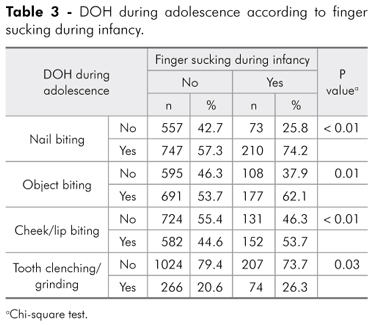Although malocclusions represent a serious public health issue, there is insufficient information about this problem in adolescents in Brazil, especially in poorer areas. The purpose of this cross-sectional study was to estimate the prevalence of facial alterations, dental malocclusions, and deleterious oral habits (DOH) among adolescents in a developing area in northeastern Brazil and to test the hypothesis that the occurrence of DOH in infancy is associated with DOH during adolescence. The study included a probabilistic population-based sample of 2,060 Brazilian students aged 12-15 years. Facial characteristics (type of facial profile, facial symmetry, and passive lip sealing) and malocclusions (Angle and Dental Aesthetic Index, DAI) were evaluated. DOH in infancy and adolescence were evaluated by interviews with the parents and adolescents. Most adolescents presented with normal facial characteristics. The malocclusion prevalence (Angle) was 83%. The DAI ranged from 13 to 69 (mean ± SD: 25.9 ± 7.7). Orthodontic treatment was necessary in 45.1% of the sample. The most prevalent DOH in adolescents were nail biting, object biting, cheek/lip biting, and bruxism, which were associated with finger sucking during infancy (P < 0.05). We conclude that malocclusions and DOH are common among Brazilian adolescents and that finger sucking during infancy may be a good predictor of DOH occurrence during adolescence.
Malocclusion; Habits; Adolescent; Brazil



